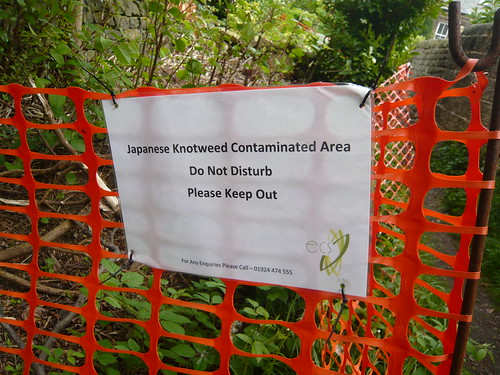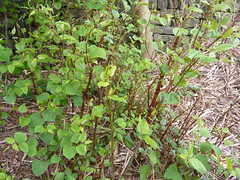Warning – Problems of Japanese Knotweed
Knotweed problems have not gone away but panic isn’t the solution.

Warning About Knotweed
- It is an offence to plant or otherwise cause the Japanese Knotweed to grow in the wild.
- Japanese Knotweed is classed as ‘controlled waste’ and as such must be disposed of safely at a licensed landfill site and buried to a depth of at least 5 m.
- This law also applies to the surrounding soil.
- Infringement can result in an unlimited fine and you can also be held liable for costs incurred from the spread of Knotweed into adjacent properties.
Problems of Knotweed
There are four main reasons why Japanese Knotweed is a problem:
- It spreads easily via rhizomes and cut stems or crowns
- It out-competes native flora
- It is difficult and expensive to control or eradicate.
- It can cause structural damage to buildings.Â
- Damage to paving and tarmac areas.
- Damage to flood defence structures.
- Damage to archaeological sites.
- Reduction of biodiversity through out-shading native vegetation.
- Restriction of access to riverbanks for anglers, bank inspection and amenity use.
- Increases erosion when the bare ground is exposed in the winter.
- Obstructs visibility and access on roads and paths.
- Reduction in land values.
- Increased risk of flooding through dead stems washed into river and stream channels.
- Increased risk of soil erosion and bank instability following removal of established stands in riparian areas.
- Accumulation of litter in well established stands
- Aesthetically unsightly.
- Expensive to treat’ Â Â -Â resource Devon County Council

This Japanese Knotweed has been colonised by Convolvulus and I can only say they deserve one another. The pink buds of Convolvulus or bind weed will open shortly into the white saucers we know well but the Japanese Knotweed is more insidious and troublesome.
Recognising Japanese Knotweed
- Japanese knotweed begins growing in early spring and can grow as much as an inch per day reaching a height of 5 feet by May and 15 feet by June.
- It produces fleshy red tinged shoots when it first breaks through the ground.
- The large, oval green leaves have a silver tinge on the underside with clusters of cream flowers towards the end of August.
- Japanese knotweed has a hollow stem, similar to bamboo and forms dense clumps that can be several metres deep.
- Japanese knotweed dies back between September and November leaving dead, brown stems but the rhizomes remain
Problems with Japanese Knotweed
- Knotweed’s stout rhizomes or underground stems, are notorious for pushing through asphalt, building foundations, concrete retaining walls and even drains, causing significant damage.
- Legally you must not allow Japanese Knotweed to spread onto adjacent land or the owner of that land could take legal action against you. Nor can you plant or encourage the spread of Japanese Knotweed including moving contaminated soil from one place to another.
- Chemical control by regular application of herbicide is the only way to eliminate the weed and it may take several years.You need permission from the Environment Agency to use herbicide near a water course.

One thought on “Warning – Problems of Japanese Knotweed”
Comments are closed.